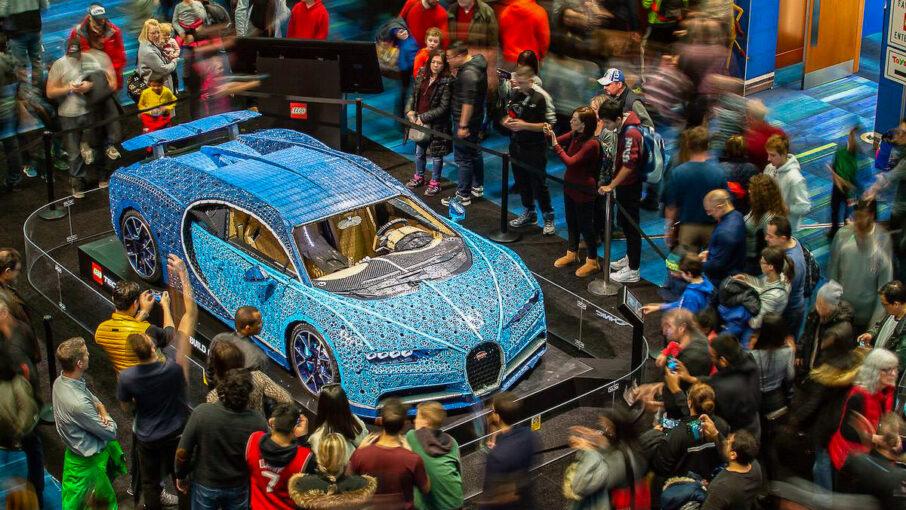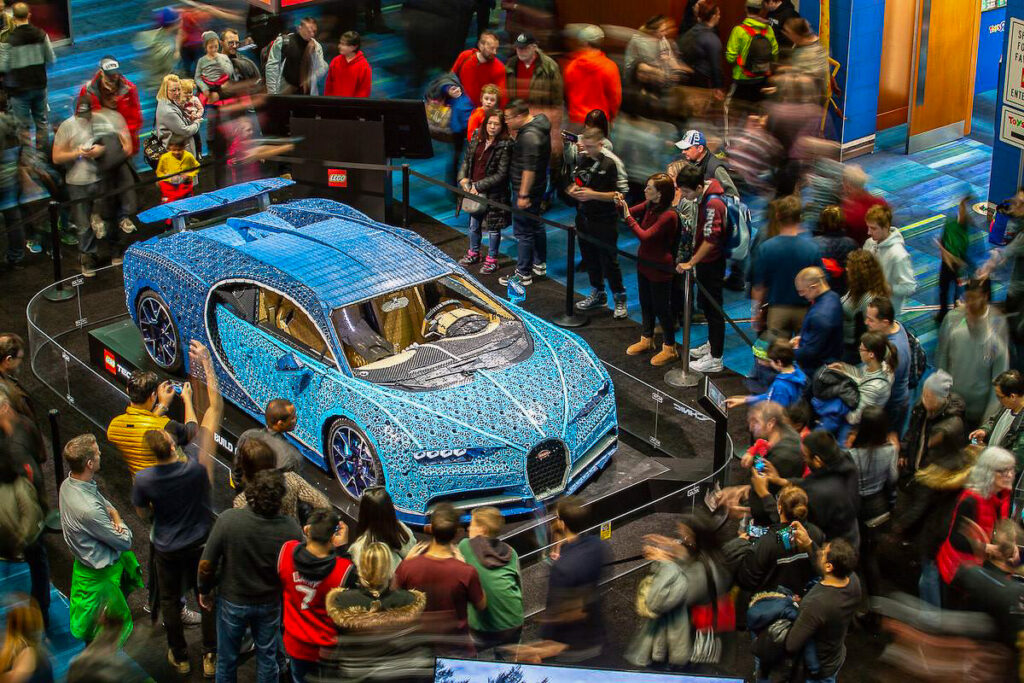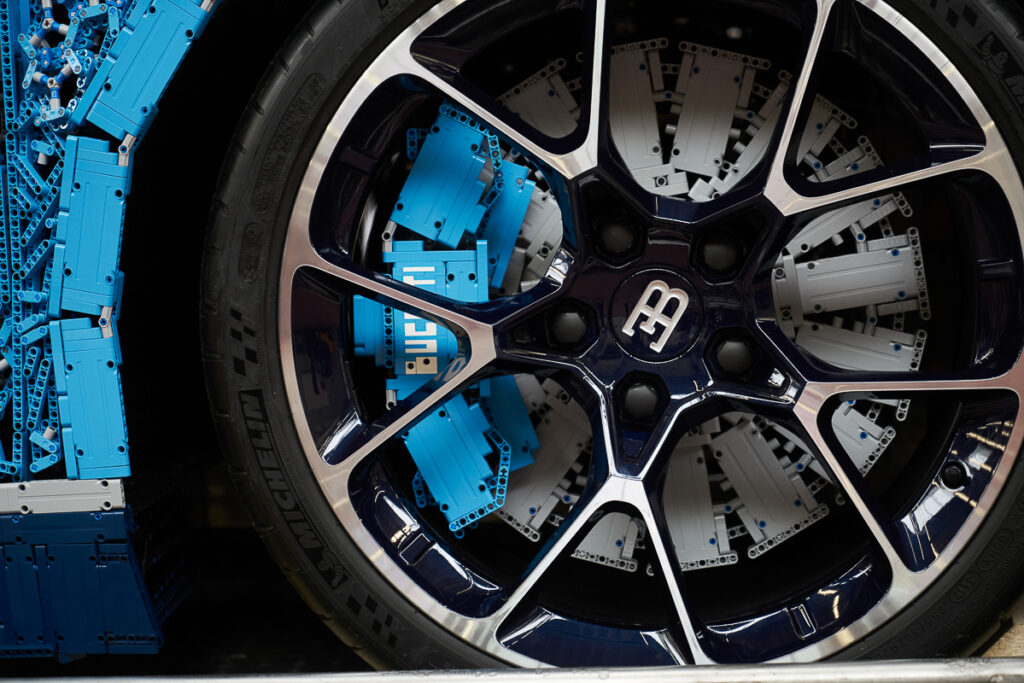How it works. Full-sized LEGO Bugatti Chiron
Feature | Impetus Novus
At the Canadian International Auto Show, Lubor Zelinka – design manager on the first-ever, full sized LEGO Bugatti ever built – explains what goes into the design, the build, the transportation, and how to actually get it to move with the help of a former 24 Hours of Le Mans winner.
Originally posted – 20 February, 2019 | Impetus Novus
Rarely has the ‘Do Not Touch’ sign at a Motor Show been more pertinent than it is today. But rogue coffee cups or greasy fingerprints from a punter’s wandering hand are the least of Lubor Zelinka’s concerns today.
For one thing, almost a year of his life has been dedicated to the full-sized Bugatti Chiron replica currently standing before us. For another, it’s the only one of its kind in the world. It’s also been built almost entirely out of Technic LEGO, meaning any damage could, quite literally, be catastrophic.
“We have only one piece, so it’s basically priceless!” Lubor explains with a cheery albeit slightly wary expression. “We do have to keep a close eye on it wherever it goes for the whole time. But we have put our trust in our logistics company and I have full confidence in the security here in Toronto. We just have to make sure that, whenever it arrives somewhere, we send a team of maybe three or four engineers to check everything is okay. We’ve not had any issues so far and I hope it stays that way!”
No kidding. To-date, Lubor and his team of 16 specialists – including experienced design, mechanical and electrical specialists – have dedicated a staggering 13,438 man hours to this project, one that has consumed over a million LEGO bricks and 339 different kinds of Technic LEGO componentry. It’s a left-field program that, when first suggested as a follow-up to its 1:8-scale $350 Bugatti Chiron kit, even LEGO’s design team thought was “insane.”
“This actually started with the 1:8 [scale] model that LEGO built in corporation with Bugatti. They were so inspired by their work with Bugatti, because it’s a brand about pushing the limits, that they came back to us and said, ‘it’s time to push ourselves, to challenge ourselves, and our limits, so let’s see if we can build a 1:1 replica of the Chiron out of Technic’. This was the first time we’d ever attempted anything like this.”
I should point out this is not Lubor’s first “crazy” project with LEGO. A technician with Denmark’s biggest toy company for almost six years now, he was also a Senior 3D Designer on the 12,000 square-metre ‘LEGO House’ the company completed in Billund two years ago. Unlike the ‘Home of the Brick’ though, the full-sized LEGO Bugatti had no predecessors, meaning most of the design, a few computer renders aside, had to be done on the fly. And, crucially, aside from a steel ladder chassis and crossbeams, almost all of the Chiron had to be built using LEGO.
No, seriously. Only those 20in / 21in wheels, the hexagonal front grille, and the ‘Macron’ badge have been carried over from the production Bugatti.
So, how has it been built?
The complexities involved are gob-smacking. To make sure the five metre-long, 2.2 metre-wide LEGO Chiron was an identical replica – “Bugatti paid a lot of attention to that, so this was a major challenge for us” – a frame, constructed entirely from LEGO, was erected to replicate the body lines, onto which the bodywork ‘skin’ (essentially a mesh of LEGO Technic triangles joined together with flexible couplings) was secured. It’s a process so intricate that Lubor and his team even fashioned a bespoke screw gun – also made from Technic LEGO – that allowed them to balloon or deflate the skin to mirror the Chiron’s curvaceous fenders and distinctive curved B-pillar perfectly.
Then there’s the rear spoiler, which can extend, retract and tilt thanks to an intricate web of Technic compressors and actuators, all of which are activated by remote control. Peer through those alloy spokes, and you’ll see that even the brake discs and pads have been made from LEGO.
“I was in charge of the design side of things, so I was working with three other designers on how the Chiron looks and how we actually built it. There were two mechanical engineers, an electrical engineer, and there were eight builders who were making everything we designed. We were really unsure how to fix the roof, for instance, because there is a steel frame in the floor but no steel above that. So the A-pillars are made from LEGO and the roof was made from LEGO, and we had to make sure they were strong enough. If we’d made a mistake, the whole thing could have collapsed and that would have cost us months.
“The doors properly open too. It was a bit of a process but, the hinges are fully LEGO, the latching mechanism is fully LEGO, and now we can open the drivers and passenger door.”
Almost on cue, Lubor’s eyes dart nervously over my right shoulder as a gentleman leans slightly too precariously over the barrier to see if the door latching mechanism really does work. He’s quickly ‘encouraged’ not to do so by the security team, and with crisis averted, Lubor continues.
“There were equipment specialists too who were constantly ordering what we needed. We wanted to make sure we didn’t run out of anything.
“But the team was just so great throughout, and we always made sure to keep motivating each other. I never regretted it. Definitely in all projects, you have high and low moments, and when you’re on the workshop floor on December 22nd at 6pm trying to get the rear wing moving, it can affect you. Or the anticipation of the first test drive – ‘is it actually going to work?’ – that will make you lose some sleep! But we never felt, ‘oh my God, this is impossible, what have we done?’ It was so cool.”
That would be an impressive enough feat right there, but the craven lunatics at LEGO Technic decided to up the ante even more by making the Brick Bugatti move under its own power too.
Are you ready? Because this is where the true “nerd frustration and happiness” happens.
How does it move?
For context, the production Chiron is powered by an 8-litre quad-turbocharged W16 that kicks out 1,500hp and 1,600Nm of torque (1,180lb ft). That’s a sizeable step forward from the 1,200hp and 1,500Nm (1,106lb ft) of which its predecessor – the Veyron 16.4 Super Sport – was capable, and is enough to punch the Chiron from 0-100kph in 2.4 seconds and 0-200kph in 6.1 seconds en-route to a 420kph top speed. Indeed, visitors to the stand in Toronto are intermittently entertained by the W16’s engine notes being blasted through speakers hidden inside the twin (block) exhaust pipes.
By comparison, its ‘sister’ model produces a “theoretical” 5.3hp and an ‘estimated’ 92Nm (68lb ft) of torque. Heroically small fry by Bugatti standards, though completely understandable. And yet, quite remarkably, the LEGO Chiron is only 3.7hp short of equalling the output of an original, 1949 Citroën 2CV. This, despite no glue being used in the construction at all.
“The real car is all-wheel drive and mid-engined. It’s the fastest street legal supercar in the world. We are also mid-engined, but we only drive the rear axle and the engine is built out of LEGO. We are using LEGO Power Functions, which are small electric motors, and if you take 2,304 of them [separated into 24 contained cubes, 96 motors per cube] and gear them together, what you get is 300kg of LEGO engine. We then send the combined power to the rear axle, where there is a gearbox we designed and built ourselves. We had to be really careful how to get the car moving because we were limited in which direction the car could move. The steering works, but if you turn the wheel too much, you could cause damage to the inside of the wheel. You can’t brake a LEGO engine either, because it would just fall apart, so we had to design two electromechanical clutches for the rear axle that cuts the power.”
24 battery cells are housed behind the front grille, provide enough juice for up to 30 minutes of drive time (more on that in a second), and allow LEGO technicians to turn on the four-bank headlights separately in customary Chiron fashion. Such is the force required to shift a half-ton 1:1 model though that Lubor’s team opted against the standard 12-volt LEGO Technic batteries for versions seven times more powerful. For safety, the drivetrain has been covered in a mesh net to stop detached LEGO bricks from falling into the gearbox, but Lubor does admit that cooling – much as it is on a production supercar – was also a concern.
“We had to solve the cooling of the engine early on, and we did a lot of experiments. We found that we had to lubricate the LEGO bricks properly so they don’t overheat. The plastic is ABS plastic, and it starts to get soft around 70 degrees.”
The test
After 10 months of sanity-shrivelling attention to detail, the day finally came for the 1,500kg brick Chiron to be transported 462km north west from LEGO Technic’s Kladno facility in the Czech Republic to Bugatti’s official test track in Ehra-Lessien, Germany, for its maiden run. Not about to do things by halves at this stage, the ‘pilot’ selected was Bugatti’s official test driver, Andy Wallace, a former 24 Hours of Le Mans winner no less.
One hackle-raising problem to solve first though: how on earth do you move a full-sized LEGO car without the bloody thing collapsing in on itself mid-transit?
“Well we couldn’t break it down and build it again, because that would be 10 months all over again! That’s one of the reasons why couldn’t do any crash tests either.
“You can see it’s standing on a podium, and there’s actually a palette hidden inside it. So for transportation, we remove the side panels, then wrap everything tightly and add supports to the front wing and the roof. We remove some parts like the rear wing, and then we pack everything into a giant crate. Usually when it goes from country to country in Europe, it goes on a flatbed truck, but this was the first time we did an airfreight to Canada. Everyone was a bit nervous about that!
“For that first test, you have a rudimentary roll cage built in the bulkhead behind the driver, and then you have a team of dedicated guys standing by, ready to rip the door off if anything bad happens. Andy was wearing a full race suit and a helmet just in case anything happened, but it was never needed.
“There’s a ladder frame beneath him, and there’s one beam running across to support it, but he sat on LEGO, the seat held him and supported him properly, and even if he rests his weight against the bulkhead, it doesn’t budge. Once he was comfortable, Andy’s fastest attempt [at Ehra-Lessien] was 25kph, and it’s actually electronically limited to 30kph, because we’re not really sure what will happen after that.”
Eight months later, and back at the Canadian International Auto Show, Lubor’s eyes have started travelling again: oh Christ, that lady posting an image to Instagram hasn’t realised how close her handbag is swinging to the wing mirror. Not wishing to test his nerves of steel any longer than I need to, I mercifully bring our conversation to a close with one final question.
Lubor and his team have just built the world’s first 1:1-scale, movable LEGO supercar. Where on Earth do they go from there?
“Personally, I’m super proud, super honoured that, here at the Auto Show, that LEGO, a toy company, is attracting so much attention. I’m always open to crazy ideas, but I’m living my dream right now. It’s taken us a long time to get here and I just want to enjoy it!”
Images | LEGO | Auto Show
Feature | Impetus Novus | James Gent













